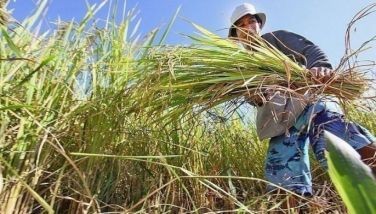Lato: Nutritious grapes from the sea
MANILA, Philippines - Have you tasted the sea?
If you have tasted fresh Caulerpa lentillifera, locally referred to as lato in Bicol or ar-arosep in the Ilocos region of the Philippines, then it’s (almost) equivalent to tasting the sea. Caulerpa lentillifera tastes like sea water, slightly salty and refreshing.
The harvested lato is washed clean and is usually eaten fresh as a salad. It can be eaten raw as an appetizer, or dipped in lemon juice or vinegar and mixed with onion and other spices.
It can also be served as a salad and eaten as snack food. Other uses include ingredient in sushi, salmon rolls, among others.
Like any product from the sea, lato is high in minerals, amino acid, and iodine, thus useful for people suffering from thyroid problems.
According to the Seaweed Industry Association, lato is high in vitamin A, C, and several essential unsaturated fatty acids.
It is also reported to have antibacterial and anti-fungal properties, and is used to treat high blood pressure and rheumatism.
There are more than 30 species and varieties of Caulerpa reported in the Philippines. But the most common is the lato because it is soft and juicy. The spherical beads bursts in the mouth, releasing its highly nutritious juice.
Lato is called “Sea Grapes’” because it resembles bunches of little grapes. The spherical beads are tightly packed together on vertical stems, which arise from long horizontal stems that creep over the ocean floor like runners.
It is also referred to as “Green Caviar” as they are synonymous to a bunch of green roe.
The color ranges from bright green to olive green. Physically, a distinctive characteristic of lato compared to other Caulerpa species is that the stalk and spherical beads are both constricted where they meet.
This type of seaweed can thrive in a variety of environments, usually on substrate composed of coral rubble or rocks to over 50 meters deep, but it is also common in shallow, muddy lagoons.
It is generally found on sandy to mussy substrates on reef flats that are not exposed during low tides and where the water is generally calm.
Indigenous in the Philippines, lato is particularly abundant in Panlatuan Cove in Pilar, Sorsogon.
According to the municipal agriculture office of Panlatuan, it grows naturally and abundantly in high level of salinity with 28-31 parts per thousand (ppt) and is usually in season from October to May.
Lato is stenohaline which means it can live only within a narrow range of saltwater concentrations. It cannot thrive in areas where salinity is less than 25 percent.
Salinities lower than 30 percent will already result in crop loss.
Growth of natural stocks in habitats where water becomes brackish during the rainy season, or those cultured in ponds, is highly seasonal.
Lato is a highly-demanded sea product, both locally and abroad, hence it is now being farmed commercially in the country.
As a high-valued ingredient in sushi, lato is exported to Japan.
Successful cultivation of lato greatly depends on its water management.
Ponds must be designed so that tidal flows can be used to change the water in the ponds every second day.
It is recommended that planting of lato is done by hand and pushed into the soft bottom of muddy aquaculture ponds in mangrove areas at 0.5-1 meter intervals.
Sometimes broadcasting is used but this is not as efficient as the plants are loose on the bottom and can be moved by water motion induced by wind action on the surface.
Lato is usually harvested two months after the first planting wherein it is pulled out of the muddy bottom. Some are left as seed for the next harvest.
Harvesting can then be done every two weeks depending on growth rates.
- Latest
























